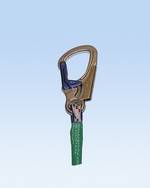Carabiner
Carabiner is a specialized type of shackle, a metal loop with a spring-loaded gate used to quickly and reversibly connect components, most notably in safety equipment and climbing gear. Carabiners are widely used in rope-intensive activities such as climbing, arboriculture, caving, sailing, hot air ballooning, rope rescue, construction, and acrobatic circus performances. They are key in ensuring the safety of these activities by providing a secure means of connection.
History[edit | edit source]
The carabiner was invented in the early 20th century by German climber Otto Herzog, who sought a faster and more secure means to connect his climbing ropes and gear. The name "carabiner" is derived from the German word Karabinerhaken (meaning "carbine hook"), which refers to the hook used by carbine riflemen to attach items to their belts.
Design and Function[edit | edit source]
Carabiners come in various shapes, sizes, and materials, typically made from steel or lightweight aluminum. The primary designs include:
- D-shaped: Offers a large gate opening and high strength-to-weight ratio.
- Oval: Uniform shape that allows for optimal positioning of equipment.
- HMS or Pear-shaped: Larger and designed for belaying and rappelling.
- Asymmetric D-shaped: A variation of the D-shape that shifts the load closer to the spine, the carabiner's strongest part.
The gate of the carabiner can be secured in several ways:
- Screw-lock: Requires the user to manually screw a sleeve over the gate to lock it.
- Twist-lock: Automatically locks the gate when closed and requires two actions to open.
- Triple-action lock: Requires three actions to open, providing an extra level of security.
Usage[edit | edit source]
In climbing, carabiners are used to connect the rope to the climbing harness, to anchor setups, and to build pulley systems. In rescue operations, they are crucial for creating secure attachment points for the rescue system. In industrial applications, carabiners are used for securing safety lines and equipment.
Safety and Maintenance[edit | edit source]
The strength and reliability of a carabiner are indicated by its kN (kilonewton) rating, which measures the maximum force it can withstand. Regular inspection and maintenance are vital to ensure the safety of carabiners, as wear, corrosion, or damage can compromise their integrity.
Environmental Considerations[edit | edit source]
While carabiners are durable, they are not immune to environmental factors. Prolonged exposure to harsh conditions can affect their functionality. Users should be aware of the conditions in which their carabiners are used and stored.
See Also[edit | edit source]
| Carabiner Resources | ||
|---|---|---|
|
| |
Navigation: Wellness - Encyclopedia - Health topics - Disease Index - Drugs - World Directory - Gray's Anatomy - Keto diet - Recipes
Search WikiMD
Ad.Tired of being Overweight? Try W8MD's physician weight loss program.
Semaglutide (Ozempic / Wegovy and Tirzepatide (Mounjaro / Zepbound) available.
Advertise on WikiMD
WikiMD is not a substitute for professional medical advice. See full disclaimer.
Credits:Most images are courtesy of Wikimedia commons, and templates Wikipedia, licensed under CC BY SA or similar.Contributors: Prab R. Tumpati, MD






